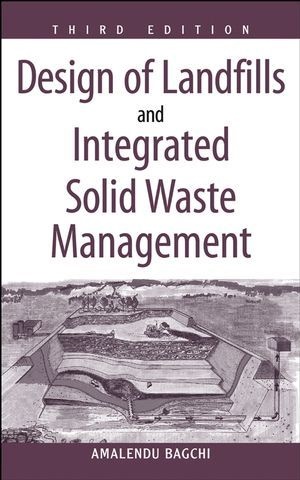Read more
Informationen zum Autor AMALENDU BAGCHI is a senior engineer with the Wisconsin Department of Natural Resources, where he is involved in various solid waste management-related initiatives, including landfill design. Klappentext By combining integrated solid waste management with the traditional coverage of landfills, this new edition offers the first comprehensive guide to managing the entire solid waste cycle, from collection, to recycling, to eventual disposal. * Includes new material on source reduction, recycling, composting, contamination soil remediation, incineration, and medical waste management. * Presents up-to-date chapters on bioreactor landfills, wetland mitigation, and landfill remediation. * Offers comprehensive coverage of the role of geotechnical engineering in a wide variety of environmental issues. Zusammenfassung By combining integrated solid waste management with the traditional coverage of landfills, this new edition offers the first comprehensive guide to managing the entire solid waste cycle, from collection, to recycling, to eventual disposal. New material is presented on solid waste management and reduction and landfill design. Inhaltsverzeichnis PREFACE. PART I: INTEGRATED SOLID WASTE MANAGEMENT. 1 Introduction. 1.1 Basic Concepts of an Integrated Solid Waste Management Program. 1.2 Scope and Organization of Book. 2 Integrated Solid Waste Management. 2.1 Planning. 2.2 Benefits of ISWM. 2.3 Regulatory Issues. 2.4 Public Promotion of ISWM. 2.5 Collection and Transportation of Waste. 2.6 Transfer Stations. 2.7 Waste Composition Study. 3 Source Reduction. 3.1 Role of Governmental Bodies. 3.2 Planning. 3.3 Source Reduction Ideas. 3.4 Reducing Toxicity. 4 Medical Waste Management. 4.1 Definition of Infectious Waste. 4.2 Source Separation and Management. 4.3 Storage. 4.4 Transportation. 4.5 Treatment. 4.6 Tracking. 4.7 Collection of Infectious Waste Generated from Homes. 4.8 Waste Reduction. 5 Incineration. 5.1 Incinerable Waste. 5.2 Waste Load Estimate. 5.3 Types of Incinerator. 5.4 Environmental Issues. 5.5 Incineration of Various Nonhazardous Waste Types. 5.6 Site Selection, Installation, and Financing. 6 Composting. 6.1 Fundamentals of Composting. 6.2 Influence of Various Parameters on Composting. 6.3 Facility Design. 6.4 Environmental Issues. 6.5 Health and Safety. 6.6 Marketing. 6.7 Economics. 7 Reuse and Recycling. 7.1 Planning. 7.2 Marketing. 7.3 Information on Recyclable Materials Recovered from Municipal Solid Waste. 7.4 Material Recovery Facilities. 7.5 Refuse-Derived Fuel Processing Plants. 7.6 Quality Control and Data Collection. 7.7 Land Spreading. 8 Reuse of Industrial By-Products. 8.1 Comments on Engineering Characteristics and Testing Protocols. 8.2 Reuse of Industrial By-Products in Civil Engineering Projects. 8.3 Environmental Issues. 9 Contaminated Soil Remediation. 9.1 Soil Contamination Process. 9.2 Factors Affecting Remedial Processes. 9.3 Contaminant Transport. 9.4 Maintenance of Wells. 9.5 Site Investigation. 9.6 In Situ Remediation Methods. 9.7 Ex Situ Remediation Methods. 9.8 Project Life Estimation. 9.9 Project Cost Estimation. 9.10 Comments on Remediation Method Selection. 10 Redevelopment of Contaminated Land. 10.1 Risk Assessment. 10.2 Risk-Based Corrective Action for Redevelopment of Contaminated Land. 10.3 Legal Issues. 10.4 Funding. PART II:LANDFILL DE...

